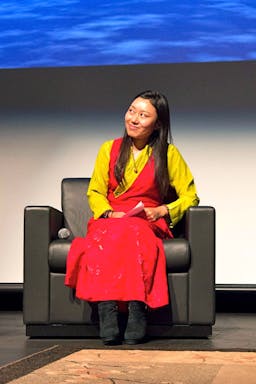Unfolding life-story...
May 28, 2019
Story
Despite the fact that women’s education is emerging as a top priority of the international development community, there are still widespread gaps, a lack of funding, and general neglect of women’s education on a global scale—as can be evidenced in my home community of Tibet in Karze County where scores of young women receive little or no education. Such neglect of women’s education is a catastrophic social issue that not only creates irreparable damages to women’s bodies and minds but also impedes the progress of society as a whole.
My own birth illustrates the challenges faced by many Tibetan women from the moment they enter the world. I was born in a narrow horse stall on a pile of straw covered with a worn-out, hand-woven rug. Long, flat, thin pieces of timber separated the horse stall from the nearby cow and yak stalls and is one of the filthiest areas of a typical two-story, mud-walled village house. My mother vividly recounts how my father piled black stones in front of our family’s gate when I was born and burned a piece of dried yak dung on top of them. The color black has a negative connotation in Tibetan and Buddhist culture. Black stones are used when a female child is born. Ironically, this practice is a way to banish evil spirits and protect the newborn child, but for girls it is the first of a lifetime of messages teaching them that they are less worthy than boys.
As a newborn girl, my arrival was not a noble or joyous event for my family. Given the Tibetan cultural view that privileges the male lineage and sees newborn girls as already “taken” or wedded to other families, my parents felt disappointment because it shattered their expectations and prayers for a boy. Even though I hold no grudges against my parents for the disappointments they experienced at my birth, I realize that a more critical educational system would have created different social conditions for my parents, thus lessening the burden they may have felt at having a girl instead of a boy when I was born.
Mostly Tibetan girls tend to mirror themselves through the lens of social stigmas and internalize the socially constructed beliefs that they are born inferior to boys and are the property of other families. Therefore, they rarely attend school and usually remain home herding livestock, doing house chores and collecting yak dung. By the time they give birth to their own children, most women in my culture have accepted their fate. They receive no prenatal or neonatal care and have no access to sanitary facilities with professional birth attendants.
Such deep-rooted social stigmas combined with poor socio-economic conditions are the primary barriers for women’s access to education in my community, Tibet. When I was in 8th grade, I had to withdraw from school for family reason. The turning point in my life came during those months when one of the Great Lamas in my village offered financial support for my schooling because he recognized my talent and potential.
This was the first of many steps that led me to discovering the world outside my village. A scholarship and more financial support brought me to Xining City, a three day bus and train trip from my village, for four more years of studies. My time in Xining gave me the opportunity to take Gender Studies and Development Studies with the Shem Women’s Group. I met inspiring women mentors who made me more conscious of the position of girls in our society and helped me to believe that I could be a source of change.
Today, I firmly believe that quality education for girls can bring about multi-dimensional changes in communities. Therefore, promoting women’s education involves changing attitudes across society as well as a great investment in quality education. In particular, it is imperative to initiate a comprehensive reform program that opens new means of engaging policy makers. I propose a bottom-up approach, where civil society and grassroots individual leaders play significant roles in shaping the societal attitudes regarding gender and give more emphasis on the importance of women’s education. Furthermore, it is necessary to improve local-level school governance in order to ensure that education programs are built to meet local people’s needs since education primarily ought to be for improving the lives of people. We need to work on quality, but not just about quantity in education, getting quality education is siginificant and only it can transform individuals and allow them to perform well in society.
I understand changing cultural attitudes towards women takes time. However, I have witnessed the changes that have occurred in my home community since I myself became an active proponent of girls’ education and other social causes. Many rural families have benefitted from my small-scale development projects and more girls are now attending school. Structural reforms, leadership initiative, and social change start from individual educators like myself because we can establish close connections and mentorships with parents, share our own educational experiences with women and inspire other young girls to be the strong force of positive changes in the society. Through one-to-one conversations, we can promote the importance of education, raise awareness about health, and help empower girls to realize their full potential. Such efforts will help all of us to discover our own talents and will challenge us to be able to vault over the obstacles and unfold our lives with gusto.




